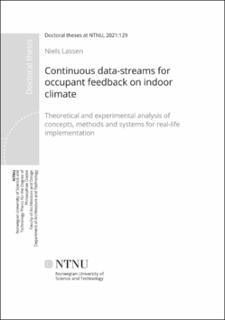| dc.contributor.advisor | Goia, Francesco | |
| dc.contributor.advisor | Mathisen, Hans Martin | |
| dc.contributor.author | Lassen, Niels | |
| dc.date.accessioned | 2021-05-03T07:18:51Z | |
| dc.date.available | 2021-05-03T07:18:51Z | |
| dc.date.issued | 2021 | |
| dc.identifier.isbn | 978-82-326-6060-5 | |
| dc.identifier.issn | 2703-8084 | |
| dc.identifier.uri | https://hdl.handle.net/11250/2740703 | |
| dc.description.abstract | One of the main purposes of a building is to provide a healthy, productive, and comfortable indoor environment. Both conventional and modern “smart” buildings can be said to fall short of this ideal. The fields of research and practice seem set on creating models and adjusting setpoints to maintain a tightly controlled and uniform indoor environment. This practice leads to (increasingly) complex buildings with high installation costs, high energy use and users who too often are frustrated and dissatisfied. After all, the approach has been to calculate the satisfaction (of comfort) level of our occupants – a highly complex task involving physics, physiology, and psychology.
The core question behind this PhD thesis was “Can’t we just ask them?”, referring to how modern sensor technology and pervasive computing technology create new possibilities for data collection in buildings. The aim of this thesis is to investigate how new technology can help realize the automated collection of subjective occupant opinions, and thus help improve the functioning, quality, and performance of both new and existing buildings.
Four methods for subjective occupant feedback were tested in five field intervention studies in Oslo and California. The results were compared to simultaneously performed interviews and surveys, which were treated as a “ground truth”. The useability and representativeness of each collection method was assessed by statistical analysis. Theoretical studies were also performed to investigate the usefulness and nature of subjective occupant feedback.
It was found that continuous subjective feedback has the potential to provide necessary knowledge and documentation to support holistic design choices and may contribute to closing the performance gaps in future buildings. A novel hierarchy was created for classifying types of occupant centric data, highlighting the information embedded in each data type. The collected data showed that public satisfaction polling stations were sensitive to non-response bias, while complaint feedback was less biased. Occupants preferred simple manual interfaces above accessing control via their smartphone. Personal heaters controlled by each occupant were “warmly welcomed” by the occupants, and the individual usage showed correlation with Thermal sensation votes on the survey.
Hopefully, the work has contributed to raise awareness of the pitfalls of deterministic comfort models and shows a path toward utilization of continuous subjective occupant feedback for design, benchmarking, tuning, and control purposes. | en_US |
| dc.language.iso | eng | en_US |
| dc.publisher | NTNU | en_US |
| dc.relation.ispartofseries | Doctoral theses at NTNU;2021:129 | |
| dc.relation.haspart | Paper 1: Lassen, Niels; Hegli, Tine; Dokka, Tor Helge; Løvold, Terje; Edwards, Kristian; Goia, Francesco; Andresen, Inger. Enabling holistic design for high energy efficient office buildings through the use of subjective occupant feedback. Sustainable cities and society 2021 ;Volum 69.
https://doi.org/10.1016/j.scs.2021.102867
This is an open access article under the CC BY license. | en_US |
| dc.relation.haspart | Paper 2: Lassen, Niels; Goia, Francesco. A theoretical framework for classifying occupant-centric data streams on indoor climate using a physiological and cognitive process hierarchy. Energy and Buildings 2021 ;Volum 241.
https://doi.org/10.1016/j.enbuild.2021.110935
This is an open access article under the CC BY license | en_US |
| dc.relation.haspart | Paper 3: Lassen, Niels; Josefsen, Terje; Goia, Francesco. Design and in-field testing of a multi-level system for continuous subjective occupant feedback on indoor climate. Building and Environment 2020 ;Volum 189.
https://doi.org/10.1016/j.buildenv.2020.107535
This is an open access article under the CC BY license | en_US |
| dc.relation.haspart | Paper 4: Lassen, Niels; Goia, Francesco; Schiavon, Stefano; Pantelic, Jovan. Field investigations of a smiley-face polling station for recording occupant satisfaction with indoor climate. Building and Environment 2020 ;Volum 185.
https://doi.org/10.1016/j.buildenv.2020.107266
This is an open access article under the CC BY license | en_US |
| dc.relation.haspart | Paper 5:
Lassen, Niels; Møller, Jan K.; Goia, Francesco.
Building trust in occupant-centric data streams - Quantifying the 2 relationships between automated feedback and manual surveys. | en_US |
| dc.title | Continuous data-streams for occupant feedback on indoor climate: Theoretical and experimental analysis of concepts, methods and systems for real-life implementation | en_US |
| dc.type | Doctoral thesis | en_US |
| dc.subject.nsi | VDP::Humanities: 000::Architecture and design: 140 | en_US |
